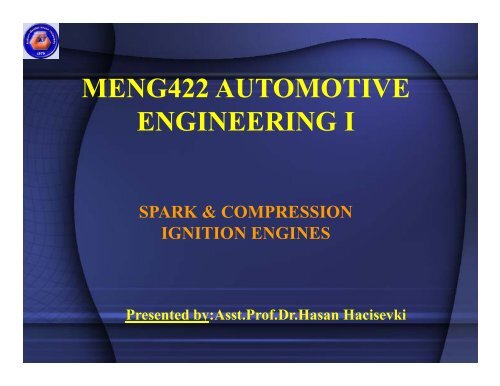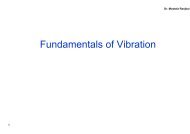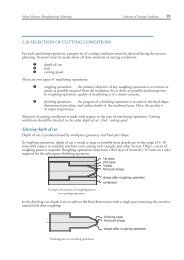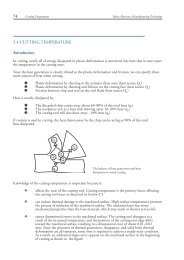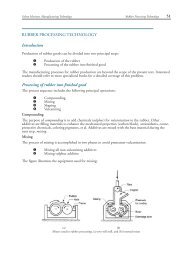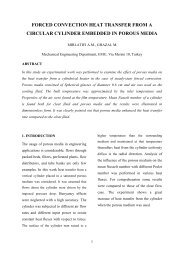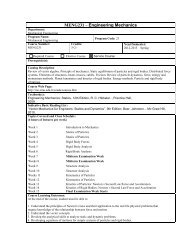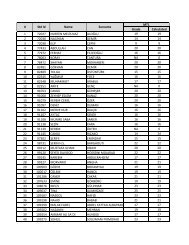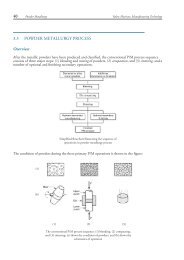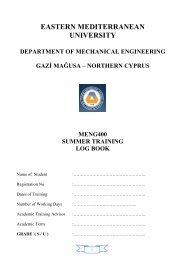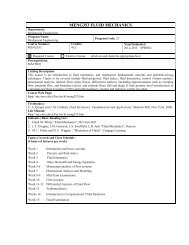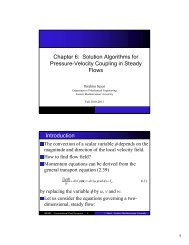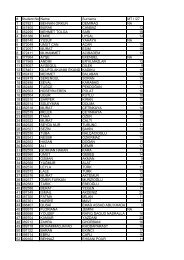Spark & Compression Ignition Engines
Spark & Compression Ignition Engines
Spark & Compression Ignition Engines
Create successful ePaper yourself
Turn your PDF publications into a flip-book with our unique Google optimized e-Paper software.
MENG422 AUTOMOTIVE<br />
ENGINEERING I<br />
SPARK & COMPRESSION<br />
IGNITION ENGINES<br />
Presented by:Asst.Prof.Dr.Hasan Hacisevki
PISTON-ENGINE BASICS<br />
There are two kinds of piston engines:<br />
1. <strong>Spark</strong>-<strong>Ignition</strong> Engine<br />
2. <strong>Compression</strong>-<strong>Ignition</strong> (Diesel) Engine
SPARK IGNITION ENGINE<br />
INTRODUCTION<br />
The actions in the spark-ignition engine can be divided<br />
into four parts. Each part consists of a piston stroke.<br />
This is the movement of the piston from BDC to TDC,<br />
or from TDC to BDC. The complete cycle of events in<br />
the engine cylinder requires four piston strokes. These<br />
are intake, compression, power and exhaust. The<br />
crankshaft makes two complete revolutions to complete<br />
the four piston strokes. This makes the engine a fourstroke-cycle<br />
engine. It is also called a four-stroke or<br />
four-cycle engine.
SPARK IGNITION ENGINE OPERATION<br />
• Intake Stroke:<br />
During the intake stroke of a spark-<br />
ignitioniti engine, the piston it is moving down.<br />
The intake valve is open. Air-fuel mixture<br />
flows throughh the intake port and into the<br />
cylinder. The fuel system supplies the<br />
mixture. it As the piston it passes throughh<br />
BDC, the intake valve closes. This seals off<br />
the upper end of the cylinder.
SPARK IGNITION ENGINE OPERATION<br />
• <strong>Compression</strong> Stroke:<br />
After the piston passes BDC, it starts<br />
moving up. Both valves are closed. The<br />
upward moving piston compresses the airfuel<br />
mixture into a smaller space, between<br />
the top of the piston and the cylinder head.<br />
This space is combustion chamber. The<br />
mixture is compressed 1/8 or less of its<br />
original volume. The amount that the<br />
mixture is compressed is compression<br />
ratio.
SPARK IGNITION ENGINE OPERATION<br />
• Power Stroke:<br />
As the piston nears TDC at the end of the<br />
compression stroke, an electric spark jumps the<br />
gap at the spark plug. The heat from the spark<br />
ignites the compressed air-fuel mixture. The air-<br />
fuel mixture then burns rapidly. These high<br />
temperatures cause very high pressure which<br />
pushes down the piston. The connecting rod carries<br />
this force to the crankshaft, which turns to move<br />
the drive wheels.
SPARK IGNITION ENGINE OPERATION<br />
• Exhaust Stroke:<br />
As the piston approaches BDC on the<br />
power stroke, the exhaust valve opens.<br />
After passing through BDC, the piston<br />
movesupagain. The burned gases escape<br />
through the open exhaust port. As the<br />
piston nears TDC, the intake valve opens.<br />
When the piston passes through TDC and<br />
starts down again, the exhaust valve<br />
closes.
DIESEL ENGINE<br />
INTRODUCTION<br />
Diesel engines are similar to spark<br />
ignition engines in construction. Both have<br />
pistons, with piston rings, moving up and<br />
down in cylinders. Both burn fuel in<br />
combustion chambers in the upper part of<br />
the cylinders. The high pressure produced<br />
by the burning fuel pushes the pistons<br />
down. This rotates the crankshaft and the<br />
rotary motion is carried through shafts and<br />
gears to the drive wheels.
System<br />
Common Rail
DIESEL ENGINE OPERATION<br />
• Intake Stroke:<br />
The diesel engine takes in air alone.<br />
No throttle valve impedes the airflow.<br />
In the spark-ignition engine, a<br />
mixture of air and fuel enters the<br />
engine cyclinders on the intake<br />
stroke. The throttle valve controls the<br />
amount thatt<br />
enters.
DIESEL ENGINE OPERATION<br />
• <strong>Compression</strong> Stroke:<br />
In the diesel engine, the upward-<br />
moving piston compresses air<br />
alone. On the other hand, in the<br />
spark ignition engine, the piston<br />
compresses the air-fuel mixture.
DIESEL ENGINE OPERATION<br />
• Power Stroke:<br />
In diesel engine, a light oil called<br />
diesel fuel is injected into the<br />
compressed and dhot air. The heat<br />
of compression ignites the fuel. In<br />
the spark-ignition engine, a spark<br />
at the spark plug ignites the<br />
compressed air-fuel mixture.
DIESEL ENGINE OPERATION<br />
Exhaust Stroke:<br />
The exhaust stroke is the same for<br />
both engines. The exhaust valve<br />
opens and the burned gases flow<br />
out as the piston moves up the<br />
cyclinder.
DIFFERENCES BETWEEN<br />
SPARK & COMPRESSION<br />
IGNITION ENGINES<br />
The type of fuel used.<br />
The way the fuel gets into the<br />
cyclinders.<br />
The way the fuel is ignited.<br />
<strong>Compression</strong> Ratios


